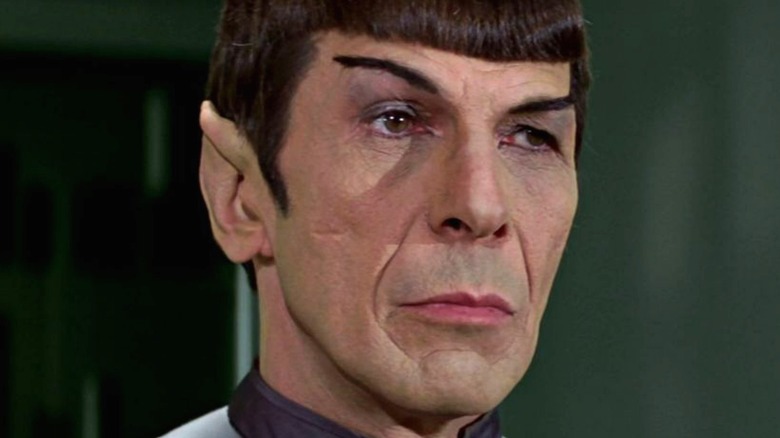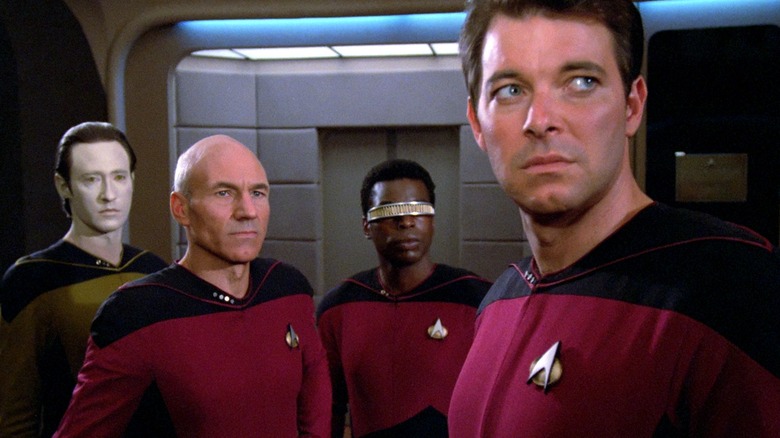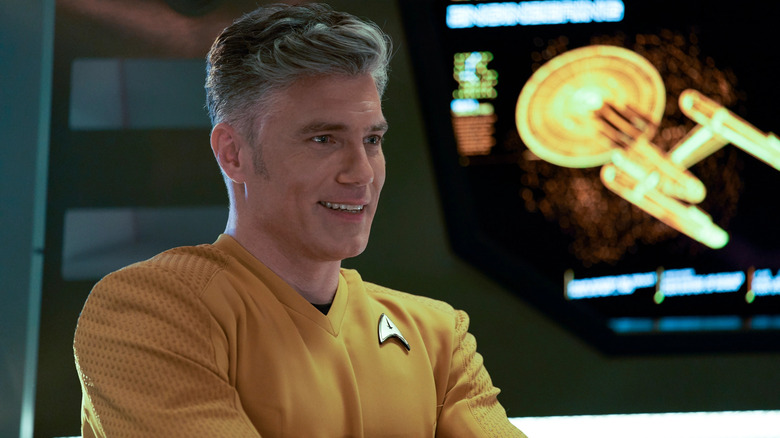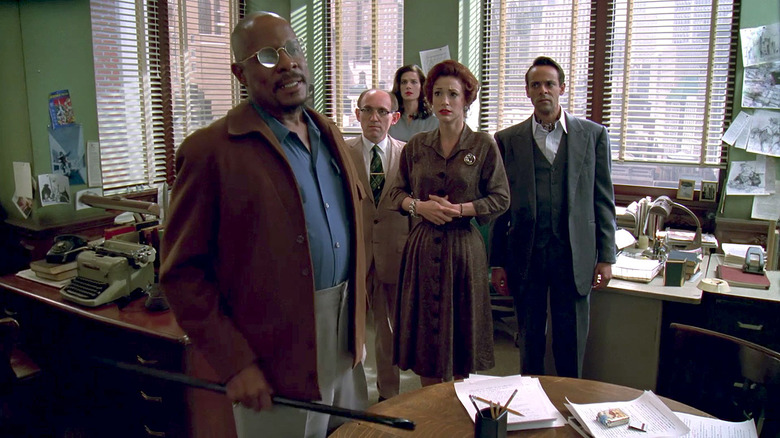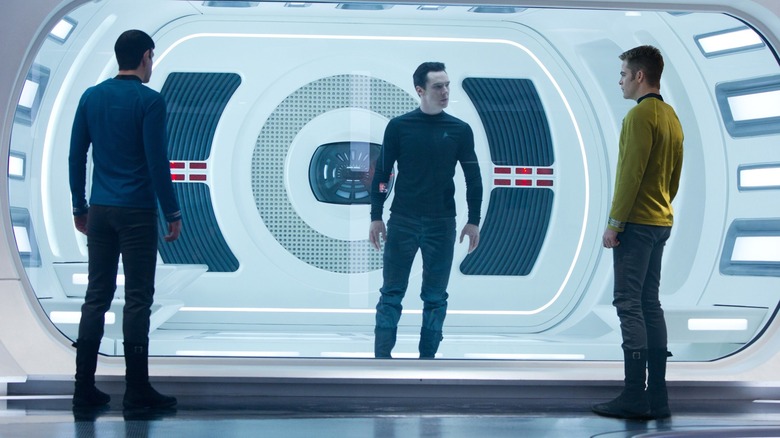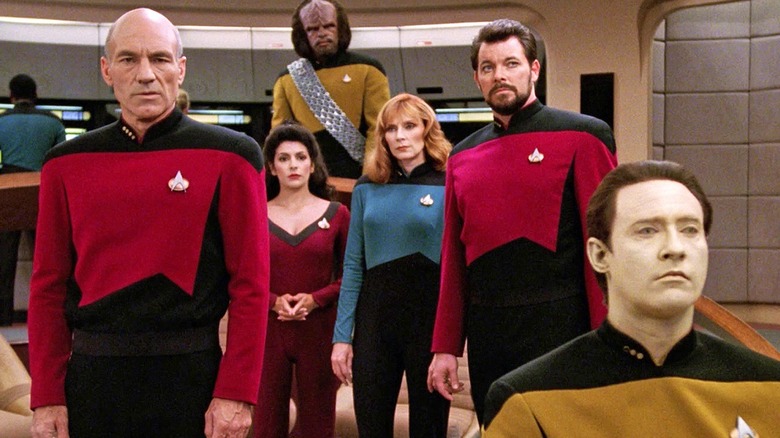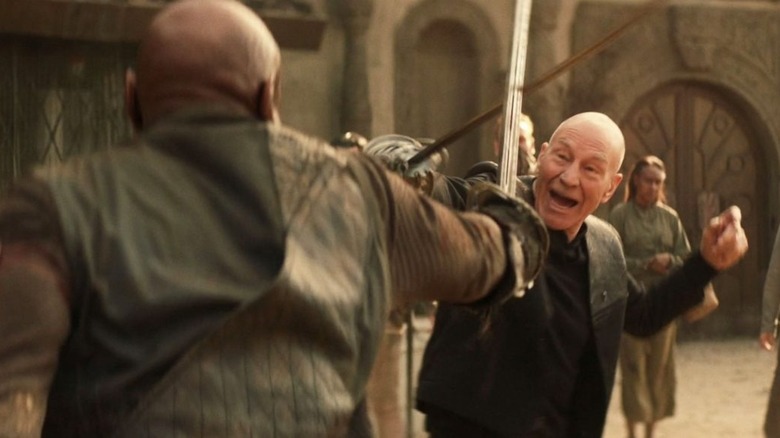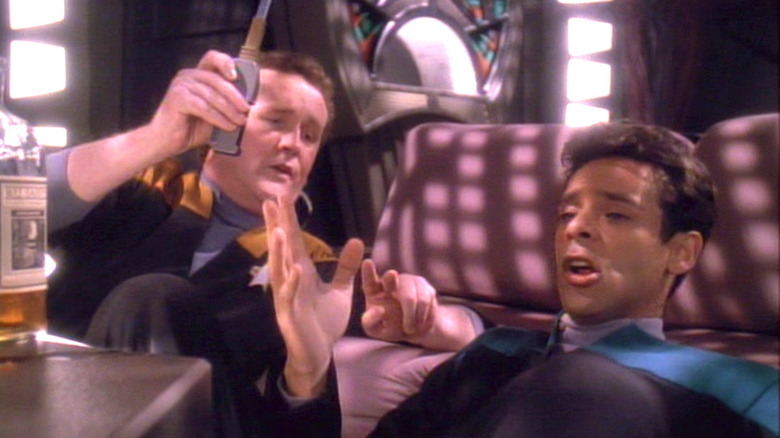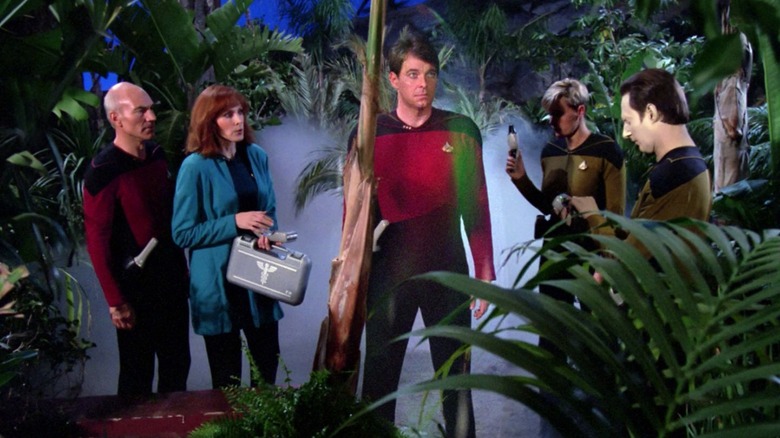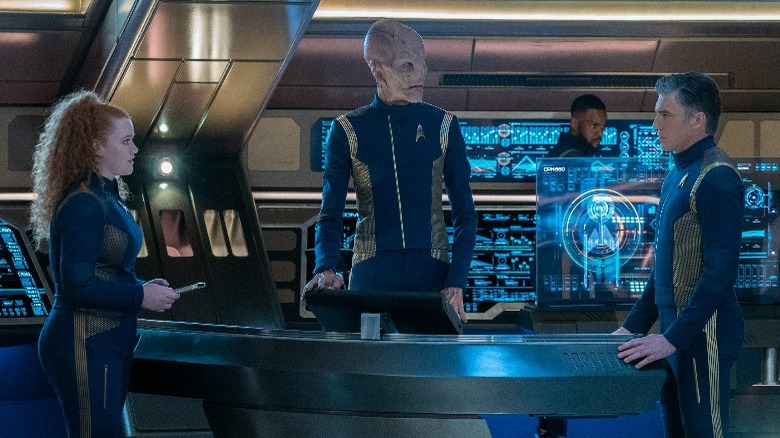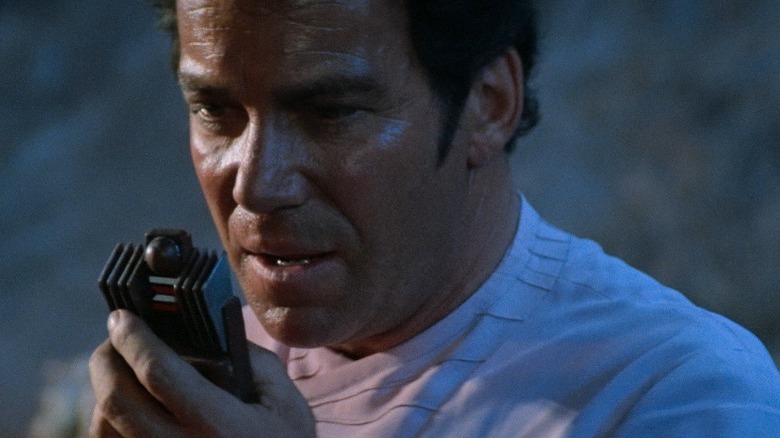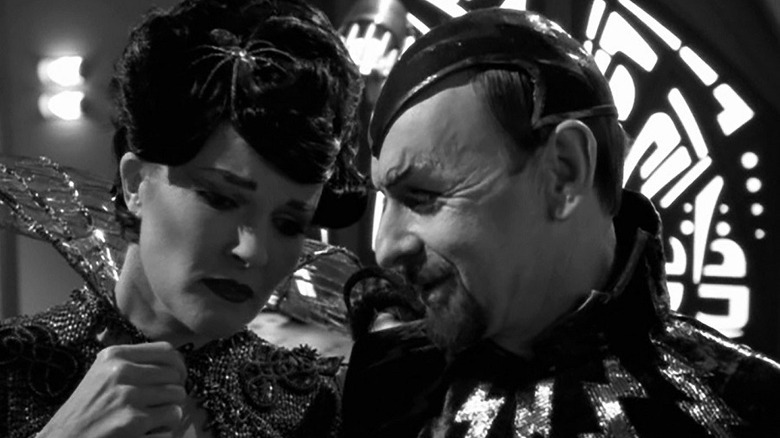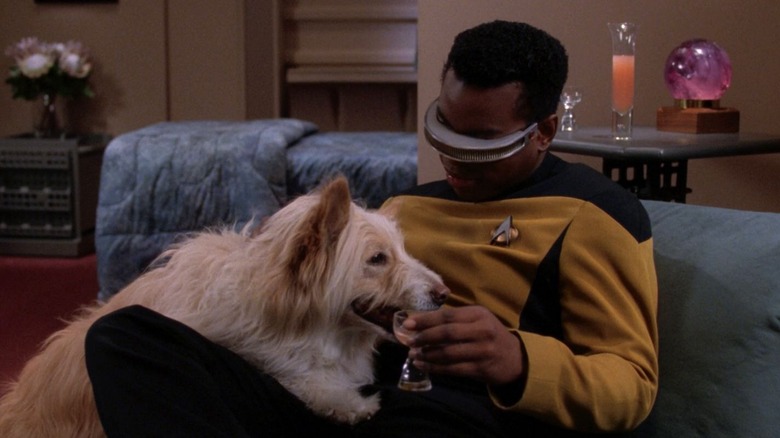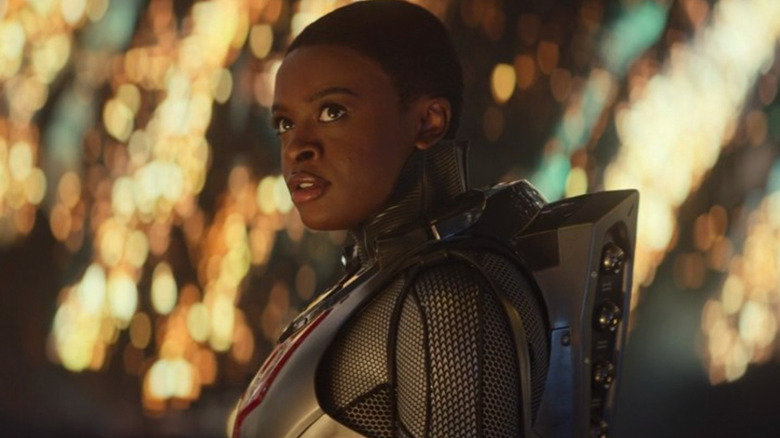Star Trek: The 7 Best And 7 Worst Things About The Franchise
"Star Trek" has astounded audiences since 1966, taking viewers on a trip through the final frontier across decades of stories on big and small screens. Every generation of fans has their own favorite captain and series, from Kirk's original adventures to Anson Mount's Captain Pike in "Strange New Worlds." A seemingly immortal franchise that has continued to reinvent itself and evolve through the decades, its success is undeniable.
Still, have you ever wondered why "Star Trek" fans are so passionate about their favorite series and why its detractors seem to sneer at it? From its groundbreaking diversity to its captivating characters, there are plenty of reasons that "Star Trek" has stayed at the forefront of science fiction for so long — so much so that we don't have enough room to talk about everything that makes it great.
However, even its biggest fans know it's far from flawless, and there are more than a few problems that have plagued it over the years. So readjust targeting scanners, synchronize pattern buffers, and prepare for transport, because we're beaming down to find the seven best and seven worst things about the "Star Trek" franchise.
Worst: Early struggles
"Star Trek" came out of the gate strong with a debut season in 1966 that delivered some of the best episodes in its run. Right away, audiences could tell this new sci-fi adventure was something far from the ordinary and nothing like the kinds of small screen space adventures they were used to. Nearly every "Star Trek" series since has stumbled a bit in the beginning.
The worst offender, surprisingly enough, is the beloved "Star Trek: The Next Generation," as Season 1 was littered with some of the worst — and at times downright offensive — episodes the franchise ever produced. While "Deep Space Nine" wasn't nearly as bad when it premiered in 1993, it too took the cast and crew some time to find its voice. While "Star Trek: Enterprise" had a few underrated episodes in its first year, according to many fans on Reddit it's easily the show's weakest, forcing producers to do some creative shuffling as it progressed.
Likewise, "Star Trek: Discovery" had a controversial debut season, leading to its own shakeups, while "Picard" mostly disappointed audiences on its premiere in 2020. Though most "Star Trek" shows have gone on to become popular with fans and critics alike, it's really a testament to Trekkies' patience and faith because plenty of the shows are guilty of having lackluster early years — but not all of them get a chance to redeem themselves.
Best: Diversity, optimism, and a hopeful vision of the future
In the 1960s, dystopian science fiction was on the rise as the Cold War raged, nuclear armageddon seemed inevitable, and the Civil Rights movement became increasingly urgent. Films like "Planet of the Apes" and "Fahrenheit 451" depicted futures where mankind succumbed to its worst impulses, where society on Earth got worse instead of better. However, along came "Star Trek" from TV writer Gene Roddenberry, who envisioned a future where humanity had grown out of its infancy, overcome its intolerance, and prospered.
At the time, this upbeat view of a hopeful future full of diversity is just what the audience craved, as its enduring popularity attests to. The original cast included a Black communications officer, a Japanese pilot, and a Russian navigator. The international crew provided a spark of hope in dark times that our troubles would one day be behind us and bigotry would be erased. Later, "Deep Space Nine" and "Voyager" would put a Black man and a woman into the captain's chair, while "Discovery" and "Strange New Worlds" feature openly gay, nonbinary, and transgender characters in prominent roles.
Suffice it to say that tolerance, diversity, and an optimistic view of the future have long been hallmarks of the franchise and among its biggest strengths.
Worst: Oversaturation
Sometimes there can be too much of a good thing. When "Star Trek: The Next Generation" became one of the hottest shows on TV, the studio wanted to continue milking its cash cow. Beginning in 1993, the next decade became a new golden age for the franchise with three spinoffs and four feature films. However, as the franchise moved forward at warp speed, the quality began to decline.
By the mid-1990s, the fictional universe seemed stretched thin with a run of seven years where there were as many as 50 episodes of "Star Trek" a year. At the same time, all four shows from the era featured similar concepts, centering on Starfleet crews adventuring in space, and what differences they did have often weren't emphasized enough. They also utilized some of the same behind-the-scenes crews, writers, and producers, leading to creative burnout and stories that sometimes felt underwritten. Ratings and box office returns both fell until the film series was shuttered and the last spinoff, "Star Trek: Enterprise," was canceled.
Today, Paramount has been smart to set every new show apart with a drastically different look and feel, while shortening seasons to as few as 10 episodes each has been helpful too. Still, we can't help but wonder if the overflow of new content — with no fewer than five shows airing new episodes in 2022 — might be leading to oversaturation once again, explaining why some series have received a divisive fan reaction.
Best: Social issues and moral messages
Some of the best science fiction luminaries, from Isaac Asimov to Ray Bradbury and Arthur C. Clarke, have used their stories to explore society's problems in the present through the lens of tomorrow. Social and political allegory are a staple of the genre, with issues of equal rights, economic inequality, and homelessness being common topics touched on by science fiction authors. Though many science fiction franchises had begun pushing more toward fantasy and adventure, content to simply dazzle audiences with outer-space action, "Star Trek" has always embraced its social conscience. Its debut in 1966 with a racially diverse cast was just the tip of the iceberg.
From the very beginning, episodes tackled racism and misogyny, while topics like political and religious extremism, gender identity, and environmental issues litter the franchise. Whether it was saving the whales in "Star Trek IV: The Voyage Home," fighting for LGBTQ rights in the "Deep Space Nine" episode "Rejoined" or commenting on political extremism in the premiere of "Strange New Worlds," some of the best and most important episodes of "Star Trek" tackle controversial topics head-on.
For most fans, what makes "Star Trek" special — and sets it apart from its contemporaries — is its fearless exploration of serious issues plaguing the world.
Worst: Repetitive stories
The most common complaint among Trekkies about the 2013 film "Star Trek Into Darkness" was its apparent rehashing of "Star Trek II: The Wrath of Khan," with a derivative nature that left something to be desired. However, looking back across the franchise reveals that repetitive stories are all too common. They might not be quite the quasi-remake that "Star Trek Into Darkness" was, but each series seems to have regurgitated many of the same plots, making more than a few episodes and movies feel formulaic.
From courtroom dramas where a crew member is put on trial to episodes where a deadly virus sweeps through the ship, there are more than a handful of stories that have become "Star Trek" cliches. For some fans, this can be part of the fun, but for newcomers or casual viewers, this can make the franchise seem tired and stale. In fact, despite universal critical acclaim — and winning the Saturn Award for best science fiction series – Season 1 of "Star Trek: Strange New Worlds" was essentially a collection of classic tropes updated for a new generation.
While "Strange New Worlds" found a way to make these formulaic plots feel fresh and innovative, the franchise's tendency to repeat its own ideas can often feel lazy — especially to its detractors.
Best: It's rewatchable and timeless
For many fans, one of the best aspects of "Star Trek" is just how timeless its stories are. Look past some of its dated visuals and you'll find stories that are just as powerful today as they were when they were written. Most "Star Trek" shows were weekly, episodic adventures too — rarely serialized — and focused on telling compelling stories rather than twist-based shockers. This has always made it perfectly suited for repeated watches, and most fans will probably tell you they watch and rewatch the classic "Star Trek" series with regularity.
Some of "Star Trek" has ventured into more adult territory — with the likes of "Discovery," "Picard," and "Lower Decks" squarely aimed at adult audiences with more mature stories, graphic violence, and adult language. Still, the vast majority of the franchise, from the original "Star Trek" through "Strange New Worlds," has been family-friendly, making it perfect to watch alone, with a partner, or with children. With so many different kinds of stories, from adventures to mysteries and beyond, there's always an episode to satisfy no matter what your mood.
With shows from every era ready for audiences of all ages, "Star Trek" is so uniquely timeless that it has become comfort food for fans of every generation.
Worst: When it tries to be dark
"Star Trek: Discovery" brought the franchise back to television with an all-new series after a 12 year absence from the small screen. This time it was a streaming original that was given an immense budget. Series creators Gretchen Berg and Aaron Harberts told Vanity Fair that they harbored dreams of the series being the next "Game of Thrones," a prestige series that would enthrall audiences and become a global sensation. It also meant a more mature tone, with some episodes even boasting a TV-MA rating — a first for "Star Trek."
Three years later, "Star Trek: Picard" brought back "The Next Generation" star Patrick Stewart, and it too went dark. The new series was a grim, dreary story that saw a downtrodden and depressed Jean-Luc Picard on a mission that took him outside the law. With a number of shocking character deaths and graphic violence, it wasn't quite what "Star Trek" fans had been expecting.
Ultimately, while critics adored both shows, the audience reaction was decidedly mixed, a fact underscored when "Discovery" was retooled with a more upbeat attitude, while Season 3 of "Picard" reunites the former captain with the "The Next Generation" cast and crew. Since "Star Trek" has been at its best when it's hopeful, optimistic, and looking towards a bright future, it's often wildly uneven when it tries to be dark, grim, and dystopian.
Best: Relatable character driven stories
Despite taking place on the final frontier and hundreds of years in the future, one of the most appealing elements of "Star Trek" is just how relatable many of its characters are, giving the various shows a likability that's hard to match in science fiction. Far from the over-the-top heroes we often meet in sci-fi and fantasy, the crews on our favorite starships often feel like people you might meet in the real world, with flaws, hangups, and problems we can all identify with.
Sure, they're often exceptional Starfleet officers, and some, like Mr. Spock on "The Original Series" and Constable Odo on "Deep Space Nine," may even possess extraordinary inhuman abilities. However, even these characters have their own difficulties that remind us of the struggles we face every day, from romantic foibles to challenges at work to family strife. Their friendships — like besties O'Brien and Bashir, Kim and Paris, and Data and Geordi — seem real and believable. These memorable characters delight us when they have good times and sadden us when we are down.
To put it succinctly, "Star Trek" has always been a character driven series that puts its people and relationships at the forefront of its stories. This is why the series has continued to resonate, connect with audiences, and keep Trekkies coming back time and time again.
Worst: Cheap looking VFX
"Star Trek" has always had fairly sizable budgets relative to its contemporaries. However, by the 1980s, audience expectations for sci-fi were sky-high thanks to a series of slickly produced big-budget features in the intervening years. While "Star Trek" continued to tell thought-provoking sci-fi parables that dazzled fans with great stories, their effects work was far from top-of-the-line.
This lack of cutting-edge effects is partly why "Star Trek" has long had a certain reputation among genre fans. While "Star Wars" was seen as the cooler, more stylish sci-fi franchise known for its incredible VFX, "Star Trek" fans pointed to its strong stories and compelling characters because it was hard to argue that it looked as good as bigger budget science fiction on the big screen. Even the movies suffered to some extent, as the budget for "Star Trek II: The Wrath of Khan" was about half that of "Star Wars: The Empire Strikes Back" two years earlier.
On television, the limited budgets continued to hamper the visuals of spin-offs like "Star Trek: Voyager" and "Enterprise." Still, for many Trekkies, the lack of high-quality, movie-like VFX has rarely been an issue. In fact, some might argue that modern "Star Trek" like "Discovery" and "Picard" put too big a focus on the CGI and effects at the expense of better stories.
Best: It puts the science in science fiction
There are many great science fiction franchises, from "Star Wars" and "Doctor Who" to the Marvel Cinematic Universe. While they all include incredible stories alongside amazing heroes and villains, most are more fantasy than true science fiction. However, "Star Trek" is more than just space adventure, superpowers, and time travel, because while most series' are happy to handwave away all of the details, "Star Trek" puts the science in the science fiction, diving into the details of how and why things work — from transporters and warp drive to phasers and tricorders.
Unlike most franchises, "Star Trek" spends entire episodes exploring the inner workings of vessels like the Enterprise, explaining things like how the warp core operates. Often, these details play critical roles in the plot. This is another reason why "Star Trek" has long had the reputation as the "nerdier" sci-fi franchise — but it's also one of the reasons Trekkies love it. Admittedly, the science is fictional, and some suspension of disbelief is still required, but the science is carefully considered, with shows often employing full-time scientific consultants to advise on scripts.
This does more than just make for interesting television, as the focus on realistic science has led the fictional world of "Star Trek" to inspire real-world technology and innovation that continues to improve our lives.
Worst: Lackluster action
When the first film in the franchise first hit theaters in 1979, it wasn't the wiz-bang action picture that more mainstream audiences may have expected following the success of "Star Wars" two years earlier. Eschewing big space battles, it was much more in line with the slower-paced, smart sci-fi stories of the original "Star Trek" series. This may have been best, because when "Star Trek" has tried to do action, it's seldom succeeded.
On television, smaller budgets and smaller sets limited what could be accomplished on primetime. More often than not, big battle sequences wisely left the action off-screen, and when it tried big stunts, the series rarely impressed. That was not a problem for most Trekkies, because they came for the stories and characters. However, it did cause problems for the movie audiences and the future of the film franchise. After the disappointing box office results of the first film, the studio often tried to turn the films into roller-coaster action movies. Unfortunately, with a cast not well-suited to play gung-ho heroes, this usually resulted in some disappointing action.
Still, on the occasions when the action has worked — such as in the J.J. Abrams movies — it usually came at the expense of the smart, thoughtful stories that "Star Trek" is known for, which can alienate longtime fans.
Best: It's never afraid to experiment and have fun
There's a little something for everyone in "Star Trek." Though it may be a science fiction series set in outer space, "Star Trek" doesn't deliver the same kinds of stories week after week, instead choosing to dabble in different genres. From horror stories to mysteries to courtroom and hospital dramas, "Star Trek" is a sci-fi procedural roulette wheel and you never know what you might find from episode to episode. It also embraces comedy more than you'd expect and is never afraid to have a little fun with light-hearted comedy that breaks up the sci-fi tension from time to time.
This vast scope in storytelling is part of what makes "Star Trek" so timeless and appealing. Plus, it's more than just variety, as it's also unafraid to experiment. In 1966, Captain Kirk told a gangster story on an alien planet, while "The Next Generation" went to Nottingham for a Robin Hood adventure. "Star Trek: Voyager" meanwhile paid homage to Flash Gordon with an episode told on the holodeck where characters adventured in a black and white retro romp. Variety even reports that Season 2 of "Star Trek: Strange New Worlds" will tell a story that will mix live action and animation as it meets the cast of "Star Trek: Lower Decks."
Though they don't always connect for a home run, it's these "big swings" that make "Star Trek" special, with a history of pushing the boundaries of the genre.
Worst: Too many filler episodes
Television isn't what it used to be, with a complete season of your average streaming series rarely more than 10-12 episodes, compared to 26-episode seasons of the '80s and '90s. However, that may be a good thing, as one of the worst sins that classic "Star Trek" and its spin-offs might be guilty of is its surprising number of filler episodes. A lot of this comes down to those longer seasons, where the behind-the-scenes personnel was forced to turn the production into an assembly line of stories, and budget crunches forced "bottle episodes" to use existing sets.
While it's true that necessity is the mother of invention and that some limitations could lead to great episodes. Still, the focus on quantity over quality when "Star Trek" was at its peak in the 1990s left each series with its fair share of forgettable and unremarkable filler episodes that could easily be skipped.
Admittedly, these fluffy, modest episodes contribute to the series' timeless and rewatchable quality. Many are still charming in their own unassuming way and offer worthwhile character development. Still, it is nevertheless eyebrow-raising that there are so many installments that are downright pedestrian and seemingly only produced to fill a quota while writers and producers concentrated their best efforts on other stories.
Best: Diplomacy and problem solving
Sci-fi on television has been known for its epic space battles, but the original "Star Trek" series set a different standard. Rather than shoot their way out of tough situations with a barrage of photon torpedoes, Captain Kirk usually chose diplomacy. Sure, the phasers were always charged and ready, but for Starfleet's finest, a negotiation was preferable, with violence a last resort, and that's always made "Star Trek" special.
Still, one of the most fun aspects of a great "Star Trek" episode is watching Kirk, Picard, Sisko, or Boimler work their way out of a jam with problem-solving skills. "Star Trek" is essentially "MacGyver" in space, with engineers and science officers working out a dilemma with their wits instead of weapons. "Star Trek" treats every crisis like a puzzle to be solved, a mystery with clues to be uncovered. Some of the best episodes didn't even have traditional villains, putting a ship and its crew into a tough spot while forcing them to think their way out.
The penchant for problem-solving has been a hallmark since "Star Trek" first debuted in 1966, and it continues today in "Strange New Worlds," "Lower Decks," and beyond. It's one of the many reasons why the franchise has traditionally worked best on the small screen and why fans keep coming back.
